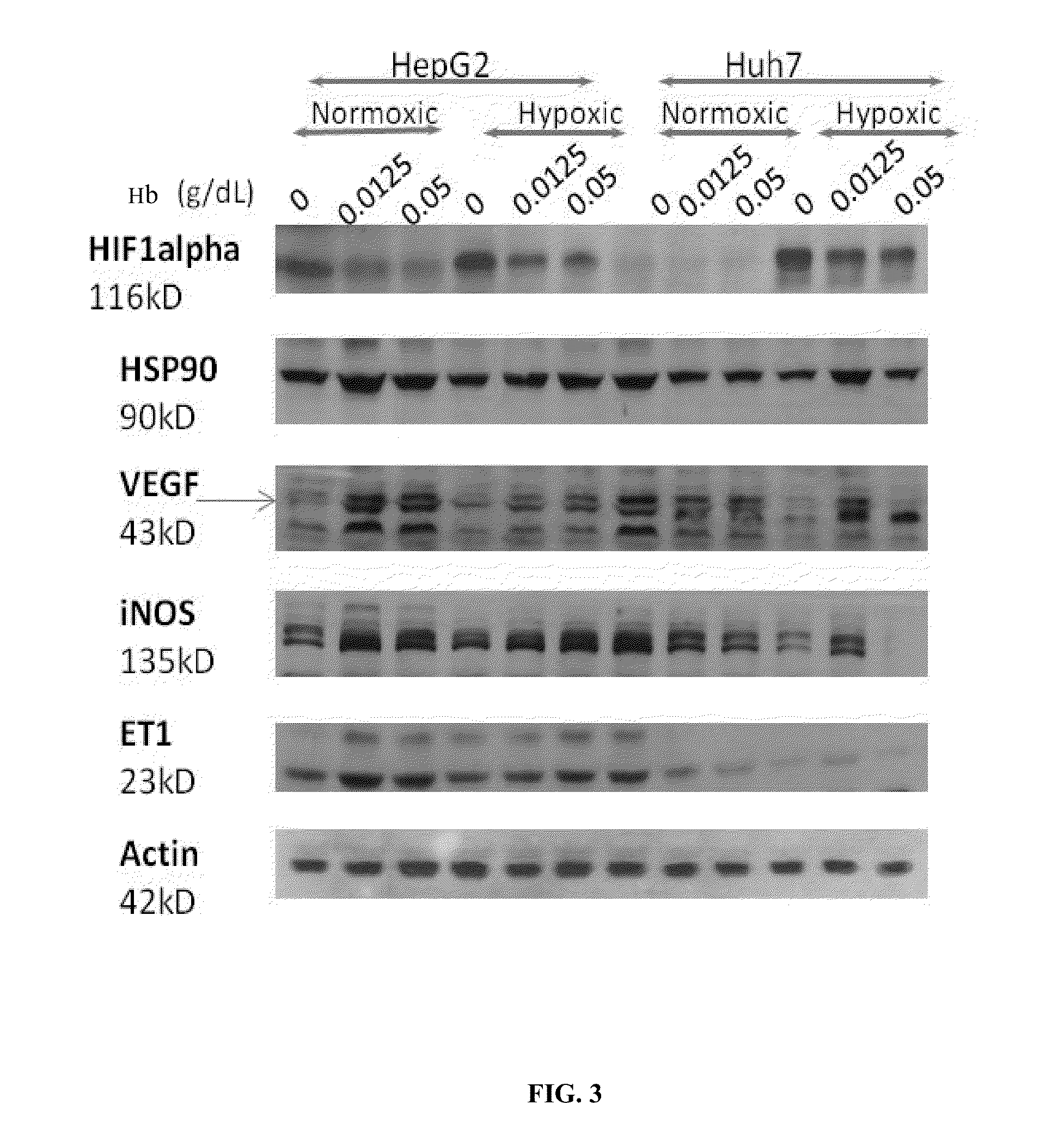Hemoglobin-based oxygen carrier-containing pharmaceutical composition for cancer targeting treatment and prevention of cancer recurrence
a technology of hemoglobin and oxygen carrier, which is applied in the direction of anti-noxious agents, peptide/protein ingredients, and therapy, etc., can solve the problems of affecting the sustainability of functional hemoglobin in circulation, affecting the survival of functional hemoglobin, and affecting the stability of plasma hemoglobin, so as to prevent cancer recurrence, target cancer treatment and prevent cancer recurrence, the effect of increasing the efficacy of both hemoglobin and cancer
- Summary
- Abstract
- Description
- Claims
- Application Information
AI Technical Summary
Benefits of technology
Problems solved by technology
Method used
Image
Examples
example 1
Culture and Reagents for Liver Cancer Cell Line
[0070]HepG2 and Huh7 cell lines are used. These cells are cultured in DMEM (Invitrogen) with 10% Fetal bovine serum (FBS), 100 U / ml penicillin and 100 μg / ml streptomycin at 37° C. For normoxic condition, cells are incubated with ambient O2 concentration and 5% CO2; for hypoxic condition, cells are incubated with 0.1-0.5% O2 (Quorum FC-7 automatic CO2 / O2 / N2 gas mixer) and 5% CO2.
example 2
Live Cell Time-Lapse Microscopy
[0071]HepG2 or Huh7 cells are seeded onto glass bottom microwell dishes (MatTek Corporation). Live cells at defined zooms (63×, 20×) are acquired using Zeiss Observer.Z1 widefield microscope, equipped with atmospheric / temperature-controlled chamber and motorized stage for multi-positional acquisition. The incubation is performed in an enclosed live cell imaging system purged with 0.1% O2 and 5% CO2 (premixed). Cells transfected with pcDNA3, pRFP-Caveolin1, or pRFP-Clathrin are exposed to HB-FITC for 15 min prior to the acquisition of images every 3 min for a period of 2 hours. Images are deconvolved and compacted into time-lapse movies using the MetaMorph software (Molecular Device).
example 3
[0072]Cell viability is measured using a 3-(4,5-dimethylthiazol-2-yl)-2,5-diphenyltetrazolium bromide (MTT) proliferation assay. Briefly, HepG2 or Huh7 cells are seeded in a 96-well flat-bottomed microplate (6000 cells / well) and cultured in 100 μL growth medium at 37° C. and 5% CO2 for 24 h. Cell culture medium in each well is then replaced by 100 μL cell growth medium, containing either no drug, Hb alone or Hb with another chemotherapeutics at their IC50 concentrations. Incubation of Hb for 24 h, 20 μL MTT labeling reagent (5 mg / mL in PBS solution) is added to each well for further 4 h at 37° C. The growth medium is removed gently, and 200 μL DMSO is then added to each well as solubilizing agent to dissolve the formazan crystals completely. The absorbance at the wavelength of 570 nm is measured by Multiskan EX (Thermo Electron Corporation), and each data point represents the means±SD from triplicate wells.
PUM
| Property | Measurement | Unit |
|---|---|---|
| molecular weight | aaaaa | aaaaa |
| molecular weight | aaaaa | aaaaa |
| molecular weight | aaaaa | aaaaa |
Abstract
Description
Claims
Application Information
 Login to View More
Login to View More - R&D
- Intellectual Property
- Life Sciences
- Materials
- Tech Scout
- Unparalleled Data Quality
- Higher Quality Content
- 60% Fewer Hallucinations
Browse by: Latest US Patents, China's latest patents, Technical Efficacy Thesaurus, Application Domain, Technology Topic, Popular Technical Reports.
© 2025 PatSnap. All rights reserved.Legal|Privacy policy|Modern Slavery Act Transparency Statement|Sitemap|About US| Contact US: help@patsnap.com



